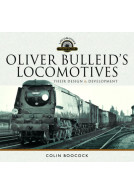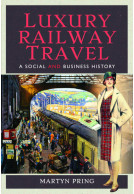The Locomotives of Robert Riddles (Hardback)
Imprint: Pen & Sword Transport
Pages: 208
Illustrations: 213 mono integrated
ISBN: 9781399099967
Published: 2nd August 2023
(click here for international delivery rates)
Need a currency converter? Check XE.com for live rates
The Locomotives of Robert Riddles guides the reader in the quest to understand how Robert Riddles career on the LMS and in war service shaped his knowledge and character and led to him becoming the obvious choice for leading the locomotive engineering function within the newly-formed Railway Executive. The book outlines the substantial impact Riddles had on the design and supply of locomotives that were to support the Allied military campaigns in the second world war, including useful analysis of the types of locomotives specifically designed for that work.
The bulk of the book outlines the decision-making processes that led to the twelve designs of standard steam locomotives that were intended to be the future stop-gap before electrification, and the political and practical reasons for successive policy changes that led to their unexpectedly short lives. Those events include the 1955 Modernisation Plan with its emphasis on dieselisation, and the subsequent railway rationalisations that reduced the need not only for new steam locomotives but also made relatively new diesels redundant. Each BR standard locomotive type is described in its own chapter. The performance of each class is given its rightful emphasis.
The book is comprehensively illustrated with largely unpublished pictures that cover a wide range of locations and locomotive duties.
"The monochrome photographs are wonderfully atmospheric...the historical context is well explained and the book production quality is high, in all, quite good value for the money."
The Railway Correspondence and Travel Society, The Railway Observer - December 2023, Volume 93
"Overall this is an informative and accessible read and worth buying if you like the BR Standards, a number of which continue to give good service on UK heritage railways along with various WDs, USAs, Hunslet Austerities and S160s."
Tenterden Terrier (Col. Stephens Railway Museum)
Robert Riddles was a British Locomotive engineer born 23rd May 1892 in Sussex, and died 18th June 1983. Amongst many of the locomotives he designed was a class 9F 2-10-0 (wheel arrangement) Number 92220 and called ‘Evening Star’ which was built at Swindon works in 1960 and withdrawn in 1965. Historically it was the 999th British Rail Standard Locomotive and the last steam locomotive to be built by British Rail.
Doncaster Family History Society
Since its British Rail working days, Evening Star operated on the Keighley & Worth Valley Railway, from 1973 - 1975: then York Railway History Museum until 1986, and then loaned to North York Moors Railway.
The book guides the reader through the career of Robert Riddles on the London Midland & Scottish Railway together with his war time service. In the early 1950’s he was the British Railways Executive to Mechanical & Electrical Engineering and was responsible for the introduction of a range of 2 cylinder standardised steam locomotives intended for service until the 1970’s.
Aided by logs, the author provides class by class comments on the locomotives designed by Robert Riddles. Colin Boocock was an apprentice at Eastleigh Works when the locomotives arrived at Eastleigh for their first overhaul, and later worked on British Railways as a chartered mechanical engineer.
As featured in
Steam World - November 2023
"Colin Boocock was apprenticed as a railway engineer and knew these classes well. He is ideally placed to assess their engineering as well as performance. Overall a good book about engines that should perhaps never have been built."
The Journal for The Society of Model & Experimental Engineers - Volume 31 - Number 5 - October 2023
About Colin Boocock
COLIN BOOCOCK is a retired railway officer whose career, mainly in mechanical and electrical engineering, spanned forty-one years full-time work on British Railways and Railtrack and a further twelve or so years in part-time consultancy.
His career started at Eastleigh Works on the Southern Region, where he was trained in the late 1950s, later going on to work at railway establishments in all of BR’s original Regions including spells in Scotland and Wales, mainly managing the maintenance of locomotives and rolling stock at a senior level.
As a life-long railway enthusiast, he travelled widely on Britain’s railways but always had a keen interest in the developments on what he still regards as his ‘home railway’, the South Western.
This volume describes in some detail the railway he grew up on: the South Western, its main lines, key railway centres and the fascinating myriad of secondary routes and branch lines.

















